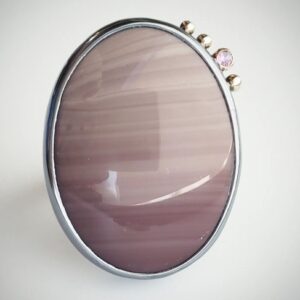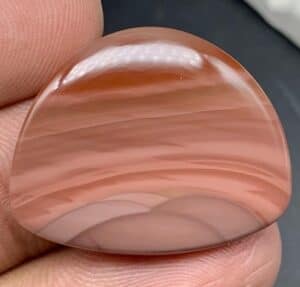Imperial Jasper is considered by gemologists and collectors to be one of five fine Jaspers. The other four on the list include Morrisonite, Bruneau Jasper, Willow Creek Jasper, and Blue Mountain Jasper. If you’re wondering what qualifies a “Jasper” to be fine then here is what to look for. As you scroll down this page you’ll notice the images of Imperial Jasper. Take a look at the rich colors and high polish. This is one factor contributing to the “fine” classification.
When you hold the Jasper in your hand you’ll notice there is no pitting or defects on the surface. Once again, this adds to the quality factor of the stone.
Guadalajara, Mexico is the main producer of Imperial Jasper. The steep canyon where the mines are located is north of the little town of San Cristobal. This Jasper-bearing area is relatively large, almost three miles long, with multiple deposits. Each deposit produces a unique type of Imperial Jasper like; Green Imperial, Brown Imperial, Select Imperial, Royal Imperial, and Spiderweb Imperial.
Types of Imperial Jasper
There are quite a few types of Imperial Jasper with large pieces weighing over 100 pounds. Many of them are named after the rich colors they display.
This variety of Jasper occurs as large-filled vugs, veins, and nodules in the host rocks. However, because of the extensive natural cracking in the deposit, most of the material found is much smaller. These deposits are rich and concentrated with over 100 tons of Imperial Jasper mined within the last decade. Many of the deposits are under claim, but the rights are complicated by multiple landowners. The amount of Jasper produced in this area is said to exceed the total lifetime production of the other varieties of fine Jasper mentioned above.
Let’s dig into the Imperial Jasper varieties.

Blue Imperial Jasper
Imperial Jasper, regardless of color, is one of the finest varieties available. These stones fall in the prestigious league of some of the best specimens, including Bruneau, Blue Mountian, Morrisonite, and Willow Creek Jasper.
What makes the Blue Imperial Jasper one of the top precious stones? It all has to do with the gold, blue, and vivid teal-blue hues that naturally decorate the stone’s surface.
Almost all Imperial Jasper is found in San Cristobal, Mexico. This region’s dense vegetation and locality provide the perfect conditions for creating these amazing stones.
You’ll notice, each stone is saturated with colorful accents, beautiful shades, and brushstrokes as if handpainted.
Blue Imperial Jasper can be found in various shades of blue. You’ll find everything from light sky blues to deep dark blue colors.

Green Imperial Jasper
The beautiful shades of green make Green Imperial Jasper highly sought-after. You will see everything from light lime green to darker leafy green colors. While green Imperial Jasper naturally occurs, some specimens are enhanced to display brighter, more vibrant colors. Don’t worry, these are fairly easy to spot. If you see a crack in the Jasper then it should be filled with a green dye which is typically used to enhance the color.

Royal Imperial Jasper
Royal Imperial Jasper is primarily located in a side canyon over a ridge to the east of the other Imperial Jasper deposits. This variety of Imperial Jasper is different in the way that it forms entirely as nodules. These nodules are usually small and flat, averaging about 2 inches.
Royal Imperial Jasper has a smooth, soft white or orangish chalky exterior and is known for having a high percentage of the “Egg” pattern.
Not all Imperial Jasper displays the egg pattern, but most Royal Imperial variety does! One thing that makes this specific Jasper deposit so unusual is that it’s the finest, largest deposit containing egg pattern Jaspers known on Earth.

Purple Imperial Jasper
Purple Imperial Jasper isn’t exactly natural, as it is enhanced or dyed to create the beautiful shades of purples seen. It is believed by many that this type of Jasper can bring one closer to their God. This stone is gorgeous, and for some, it contains a lot of spiritualism. Some believe this stone can halt the agony experienced in the present life and elevate us to a soulful life.

Red Imperial Jasper
Mexican Red Imperial Jasper or Red Imperial Jasper produces stunning shades of red with circular patterns. It can be found near the border of Zacatecas and Jalisco, Mexico, about 50 miles northwest of Guadalajara. This deposit covers a larger area on the steep slope of a canyon, in the same places where the other Imperial Jasper varieties are found. The shades of red will range from a very light color (almost pink) to deeper, darker shades.
Imperial Rainbow Jasper
Imperial Rainbow Jasper should not be confused with Rainbow Jasper, that’s found in Africa and India. Most of the material you can find online is fake or man-made. Miners will take the left over pieces of Jasper and mix them in some type of binder to press them into a solid piece of material. This allows them to create beads, trinkets, and small carvings.
The color in the material is lacking so they will dye them a bright green, pink, or purple.
Is Imperial Jasper Dyed?
You can find both natural and dyed Imperial Jasper. You will also find treated and color-enhanced Imperial Jasper.
Imperial Jasper is usually found in shades of yellow, red, brown, green, and rarely blue. Red is the most common, and the color is caused by iron inclusions.
- Identify Enstatite - March 12, 2024
- Identify Cerussite - March 3, 2024
- Identify Bytownite - February 18, 2024
